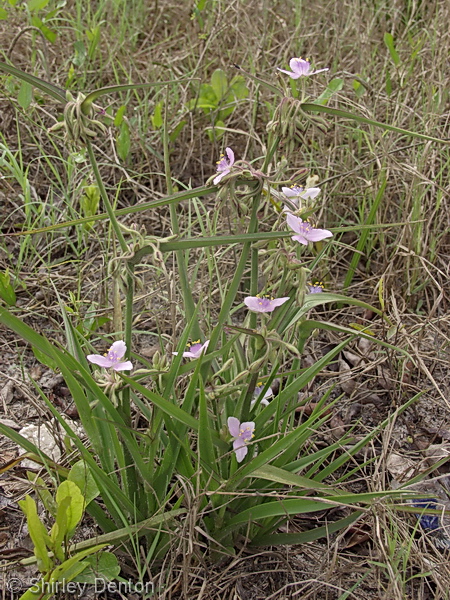Difference between revisions of "Tradescantia roseolens"
KatieMccoy (talk | contribs) |
KatieMccoy (talk | contribs) |
||
| Line 33: | Line 33: | ||
==Ecology== | ==Ecology== | ||
===Habitat=== <!--Natural communities, human disturbed habitats, topography, hydrology, soils, light, fire regime requirements for removal of competition, etc.--> | ===Habitat=== <!--Natural communities, human disturbed habitats, topography, hydrology, soils, light, fire regime requirements for removal of competition, etc.--> | ||
| − | + | Habitats of ''T. roseolens'' include Florida rosemary balds, oak scrubs, hammocks, sandhills, pinewoods, and roadsides<ref name="eol">[[http://eol.org/pages/523745/details]]Encyclopedia of Life. Accessed: March 21, 2016</ref><ref name="fsu">Florida State University Robert K. Godfrey Herbarium database. URL: http://herbarium.bio.fsu.edu. Last accessed: November 2015. Collectors: Steven P. Christman, Robin B. Huck. States and Counties: Florida: Highlands. Compiled by Tall Timbers Research Station and Land Conservancy.</ref>. Associated species include ''Ceratiola, Quercus inopina, Q. geminata'' and ''Q. chapmanii''. In Florida rosemary balds, ''T. roseolens'' was found to be positively associated with patch isolation<ref name="quintana">Quintana-Ascencio, P. F. and E. S. Menges (1996). "Inferring Metapopulation Dynamics from Patch-Level Incidence of Florida of Scrub Plants." Conservation Biology 10(4): 1210-1219.</ref>. | |
| − | |||
| − | Habitats of ''T. roseolens'' include Florida rosemary balds, oak scrubs, hammocks, sandhills, pinewoods, and roadsides<ref name="eol">[[http://eol.org/pages/523745/details]]Encyclopedia of Life. Accessed: March 21, 2016</ref>. | ||
===Phenology=== <!--Timing off flowering, fruiting, seed dispersal, and environmental triggers. Cite PanFlora website if appropriate: http://www.gilnelson.com/PanFlora/ --> | ===Phenology=== <!--Timing off flowering, fruiting, seed dispersal, and environmental triggers. Cite PanFlora website if appropriate: http://www.gilnelson.com/PanFlora/ --> | ||
Revision as of 10:27, 21 March 2016
| Tradescantia roseolens | |
|---|---|

| |
| Photo by Shirley Denton (Copyrighted, use by photographer’s permission only), Nature Photography by Shirley Denton | |
| Scientific classification | |
| Kingdom: | Plantae |
| Division: | Magnoliophyta - Flowering plants |
| Class: | Liliopsida – Monocotyledons |
| Order: | Commelinales |
| Family: | Commelinaceae |
| Genus: | Tradescantia |
| Species: | T. roseolens |
| Binomial name | |
| Tradescantia roseolens Small | |

| |
| Natural range of Tradescantia roseolens from USDA NRCS Plants Database. | |
Common name: longleaf spiderwort
Contents
Taxonomic notes
The specific epithet roseolens is derived from the fragrant tea-rose smell emitted from the flower[1].
Description
A description of Tradescantia roseolens is provided in The Flora of North America.
T. roseolens is similar to T. longifolia; however, T. roseolens can be differentiated by having smaller fragrant flowers and glandless stems[1].
Distribution
Alabama, Florida, Georgia, and South Carolina. It is listed as imperiled in Georgia[2].
Ecology
Habitat
Habitats of T. roseolens include Florida rosemary balds, oak scrubs, hammocks, sandhills, pinewoods, and roadsides[3][4]. Associated species include Ceratiola, Quercus inopina, Q. geminata and Q. chapmanii. In Florida rosemary balds, T. roseolens was found to be positively associated with patch isolation[5].
Phenology
Seed dispersal
Seed bank and germination
Fire ecology
Pollination
The following Hymenoptera families and species were observed visiting flowers of Tradescantia roseolens at Archbold Biological Station (Deyrup 2015):
Halictidae: Lasioglossum nymphalis, L. placidensis, L. puteulanum
Use by animals
Diseases and parasites
Conservation and Management
Cultivation and restoration
Photo Gallery
References and notes
Deyrup, M.A. and N.D. 2015. Database of observations of Hymenoptera visitations to flowers of plants on Archbold Biological Station, Florida, USA.
Florida State University Robert K. Godfrey Herbarium database. URL: http://herbarium.bio.fsu.edu. Last accessed: November 2015. Collectors: Steven P. Christman, Robin B. Huck. States and Counties: Florida: Highlands. Compiled by Tall Timbers Research Station and Land Conservancy.
- ↑ 1.0 1.1 Small, J. K. (1924). "Plant Novelties from Florida." Bulletin of the Torrey Botanical Club 51(9): 379-393.
- ↑ [[1]]NatureServe. Accessed: March 21, 2016
- ↑ [[2]]Encyclopedia of Life. Accessed: March 21, 2016
- ↑ Florida State University Robert K. Godfrey Herbarium database. URL: http://herbarium.bio.fsu.edu. Last accessed: November 2015. Collectors: Steven P. Christman, Robin B. Huck. States and Counties: Florida: Highlands. Compiled by Tall Timbers Research Station and Land Conservancy.
- ↑ Quintana-Ascencio, P. F. and E. S. Menges (1996). "Inferring Metapopulation Dynamics from Patch-Level Incidence of Florida of Scrub Plants." Conservation Biology 10(4): 1210-1219.